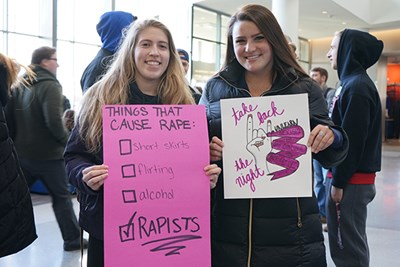Asst. Profs. Amber Horning Ruf and Ryan Shields Win National Institute of Justice Grants
 Image by Adrien Bisson
Image by Adrien Bisson
05/22/2020
By Katharine Webster
Signs of sex trafficking aren’t hard to find if you know where to look. Massage parlors are tucked into urban and suburban strip malls. Escort services advertise online. Internet porn is just a click away.
But sex trafficking is just part of the problem. Labor trafficking is even more prevalent, although less understood, because victims are working out of view on farms and in factories, as domestic servants or on construction sites.
Sex and labor trafficking are epidemic, says Asst. Prof. Ryan Shields, who brings a public health approach to his research in the School of Criminology and Justice Studies – and the first step in addressing an epidemic is to understand how far it has spread and who is affected by it.
“Right now, we don’t have reliable estimates of how many people are affected. The estimates on the number of victims range wildly, from 1,400 to 300,000 people a year,” Shields says. “We don’t have a good methodology for counting them because it’s a hidden problem: Human trafficking takes place in the shadows. We’re trying to better measure the problem so we can better understand it.”
So Shields, along with Department Chairman Sheldon Zhang, Assoc. Prof. Kelly Socia and independent researcher Michael Shively will work with law enforcement, hospitals and social service providers in several locations to identify victims, using a brief survey and data sharing among the agencies.
Shields’ research is funded by a $500,000 National Institute of Justice grant. It’s one of two NIJ grants won this year by criminal justice faculty for research into labor and sex trafficking. The other grant, also for $500,000, was awarded to Asst. Prof. Amber Horning Ruf, who researches how people are groomed to become pimps and sex traffickers.
 Image by Courtesy
Image by Courtesy
Shields’ group will also interview some identified victims. He hopes the data they glean will address unanswered questions about human trafficking and help agencies to direct resources and interventions where they can make a difference.
Few people understand the market in labor trafficking, which is bigger than the sex trafficking market according to previous research by Zhang, Shively and others. And many people believe that most victims of sex trafficking are abducted and forced into prostitution by strangers.
The reality is different, Shields says. Many trafficking victims come from difficult family situations where they have been subjected to physical or sexual abuse and neglect as children or teens. Most are from low-income families, and many are LGBTQ youth who have been kicked out of their homes and then turn to paid sex to survive.
“These are kids who have been victimized and exploited in so many other ways before they become victims of the commercial sex trade,” he says. “The field can’t afford to lose that context and that focus. We need to target interventions early.”
Horning Ruf’s research also turns some stereotypes on their heads. As a graduate student at John Jay College of Criminal Justice in New York, she interviewed more than 200 underage sex workers and trafficking victims in Atlantic City, N.J. Horning Ruf and her colleagues had expected most of the teenagers to have pimps – but only 10 percent of them said that they did.
That intrigued her, so for her dissertation research, Horning Ruf decided to interview pimps and sex traffickers in New York to find out how they entered the market and the tasks they performed.
About one quarter of the 85 men she interviewed had been brought up in families of pimps, who groomed them for the trade, some from as young as age 9. Others got into the trade as “facilitators” – a child paid by a prostitute to insulate her from arrest by hanging out on the street and bringing customers to her.
Horning Ruf also learned that the women who earn the most money for their pimps often end up running the business, from recruiting new workers to keeping the books, effectively becoming traffickers themselves.
The new grant will fund an expansion of Horning Ruf's research and similar research by Prof. Loretta Stalans of Loyola University Chicago. They will each interview equal numbers of pimps and top-earning prostitutes – Horning Ruf in New York City and Stalans in Chicago – to better understand how those in the commercial sex trade are groomed for the job and how they are connected, both socially and commercially.
Ultimately, they hope their research will lead to better interventions, especially for children and teens being inducted into the trade.
“Sex trafficking and organized crime are not as connected as people once imagined, so what do the networks look like?” Horning Ruf says. “We’re also trying to understand from a law enforcement perspective whether these women and young men who’ve been groomed, or children acting as facilitators, should be regarded as sex traffickers or as victims. The boundaries can be very fluid.”




